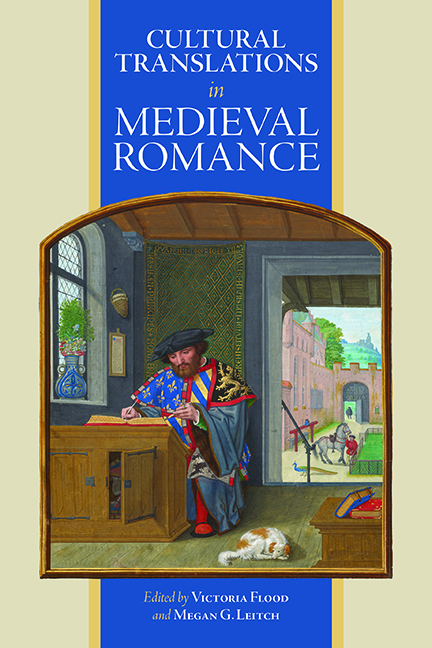Book contents
- Frontmatter
- Contents
- List of Contributors
- List of Abbreviations
- Introduction Insular Romance in Translation: New Approaches
- 1 Romantic Wales: Imagining Wales in Medieval Insular Romance
- 2 ‘Something remains which is not open to my understanding’: Enigmatic Marvels in Welsh Otherworld Narratives and Latin Arthurian Romance
- 3 The Supernatural Company in Cultural Translation: Dafydd ap Gwilym and the Roman de la Rose Tradition
- 4 Women and Werewolves: William of Palerne in Three Cultures
- 5 ‘Better a valiant squire than a cowardly knight’: Gender in Guruns strengleikr (The Lay of Gurun)
- 6 ‘Vinegar upon Nitre’? Walter Map’s Romance of ‘Sadius and Galo’
- 7 The Three Barriers to Closure in Hue de Rotelande’s Ipomedon and the Middle English Translations
- 8 Trojan Trash? The Seege or Batayle of Troye and the Learning of ‘Popular’ Romance
- 9 Poaching Romance: Fan Fiction Theory and Shared Medieval Narratives
- 10 Between Epic and Romance: The Matter of England and the Chansons de Geste
- 11 Geographies of Loss: Cilician Armenia and the Prose Romance of Melusine
- 12 ‘All this will not comfort me’: Romancing the Ballad in The Squire of Low Degree
- 13 Merchants in Shining Armour: Chivalrous Interventions and Social Mobility in Late Middle English Romance
- Index of Manuscripts
- General Index
- Miscellaneous Endmatter
1 - Romantic Wales: Imagining Wales in Medieval Insular Romance
Published online by Cambridge University Press: 07 October 2022
- Frontmatter
- Contents
- List of Contributors
- List of Abbreviations
- Introduction Insular Romance in Translation: New Approaches
- 1 Romantic Wales: Imagining Wales in Medieval Insular Romance
- 2 ‘Something remains which is not open to my understanding’: Enigmatic Marvels in Welsh Otherworld Narratives and Latin Arthurian Romance
- 3 The Supernatural Company in Cultural Translation: Dafydd ap Gwilym and the Roman de la Rose Tradition
- 4 Women and Werewolves: William of Palerne in Three Cultures
- 5 ‘Better a valiant squire than a cowardly knight’: Gender in Guruns strengleikr (The Lay of Gurun)
- 6 ‘Vinegar upon Nitre’? Walter Map’s Romance of ‘Sadius and Galo’
- 7 The Three Barriers to Closure in Hue de Rotelande’s Ipomedon and the Middle English Translations
- 8 Trojan Trash? The Seege or Batayle of Troye and the Learning of ‘Popular’ Romance
- 9 Poaching Romance: Fan Fiction Theory and Shared Medieval Narratives
- 10 Between Epic and Romance: The Matter of England and the Chansons de Geste
- 11 Geographies of Loss: Cilician Armenia and the Prose Romance of Melusine
- 12 ‘All this will not comfort me’: Romancing the Ballad in The Squire of Low Degree
- 13 Merchants in Shining Armour: Chivalrous Interventions and Social Mobility in Late Middle English Romance
- Index of Manuscripts
- General Index
- Miscellaneous Endmatter
Summary
At least since the nineteenth century, with the popularity of Matthew Arnold's idealised view of a culture he described as ‘Celtic’, Wales has been regarded from the outside as a ‘romantic’ place. Arnold did not entirely invent this view of Wales but was drawing on earlier traditions of poetry and travel writing by English writers who each thought they were discovering something new about the landscape and history of Wales. This view of Wales as somewhere undiscovered, somewhere beyond everyday experience, and thus in some sense threatening to the prevailing order of English hegemony, is actually as old as the early encounters between Britons and Saxons in the sixth century, but the origins of the Arnoldian version of Celticity can be located most securely in the centuries from the twelfth to the fifteenth, when the genre of medieval romance flourished and then declined.
In this chapter I aim to explore ways in which medieval insular romance worked to construct a place that we might call ‘romantic Wales’, that is, an imagined geographical and topographical site where romance phenomena (mystery, adventure, love) might be found, a place marked for romance like the crusader cities of the East or the enchanted forests of Brittany. But what was the nature of this geographical site which was called ‘Wales’, and does it map onto what we now think of as Wales, as it appears on a modern map of Britain? My approach to answering these questions draws on the field of spatial humanities, especially the assumed link between space and ideology, such that ‘places, including geographies in the medieval context of the romance, did not simply serve as settings or backgrounds and may have been carefully selected to serve an ideological purpose or awaken meaningful associations’. Romantic Wales as an imagined site in medieval literature comes already endowed with a whole set of ‘meaningful associations’ which enable romance writers to use it as a kind of shorthand for the adventures that are to come.
Like other imagined spaces in medieval romance, the idea of ‘Wales’ was not stable throughout the Middle Ages. I want to suggest that before about 1300 romantic Wales existed immanently across the whole of the territory, from the Norman lordships to the lands of the independent Welsh princ-es. After 1300, following the loss of native Welsh rule, romantic Wales no longer comprised the whole geographical country but was reduced in size, occupying only those lands in the north and west which had once belonged to the native princes.
- Type
- Chapter
- Information
- Cultural Translations in Medieval Romance , pp. 21 - 44Publisher: Boydell & BrewerPrint publication year: 2022



